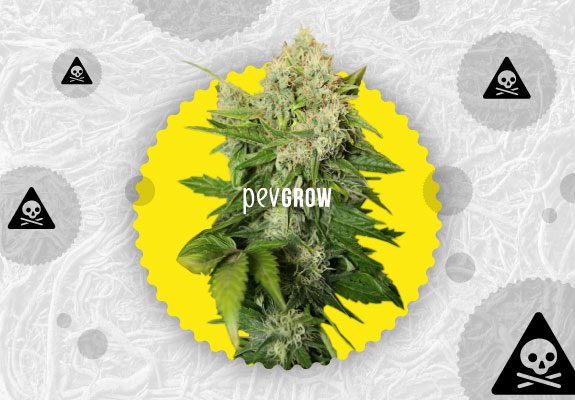

08-11-2019 09:30:39 - Updated: 8 November, 2019
When we grow marijuana we can find many types of mushrooms, especially if the conditions are not the best (identify the pests here). Fungi reproduce through spores, microscopic particles that move through the air and wherever they find the ideal conditions for their development they stay. The most common ones we see in cannabis crops are these:
- Powdery mildew
- Botrytis
- Mildew
- Fusarium
- Pythium
- Rust
- Bold
- Alternaria alternate
- Nursery disease (Damping-off)
⚠️ What is Powdery mildew and how does it affect cannabis?
Oidium is a fungus of the Erisifaceae family, which is increasingly common in cannabis crops. It manifests as a kind of white powder on the leaves and at first sight can be confused with mildew. It usually appears in indoor crops and greenhouses rather than outdoors, as it arises when a certain heat is accompanied by sudden changes in humidity.
The spores of the Powdery mildew rest on the top of the leaves, and when the conditions are met they produce a kind of root that is responsible for sucking nutrients. Little by little it expands over the entire surface of the leaf and passes to others, and then the leaves turn yellow and fall off.
How can I prevent or eliminate Powdery mildew?
The best thing is to prevent it from appearing and to do so you need several things. The first thing to do is to keep the growing space as clean as possible. Also keep the humidity as constant as possible, and a temperature that does not rise above 27 º C. nor under 18 º C. And spray the plants with propolis weekly from the second week of growth.
If you have to fight against Powdery mildew fortunately there are enough effective products on the market, such as OidioProt, Oidio Killer or Flower’s powdery mildew fungicide.
Are there homemade remedies to fight powdery mildew?
Yes, there are, and also quite effective if handled in time. Sodium bicarbonate has antiseptic, antibacterial and fungicidal properties among others.
To eliminate oidium with bicarbonate it is necessary to mix water, oil and sodium bicarbonate in these proportions: 1 litre of water, 2 tablespoons of olive oil and 2 tablespoons of sodium bicarbonate. We mix everything well and with this solution we pulverize all the plants properly, with special emphasis on areas where we see oidium sprouts.
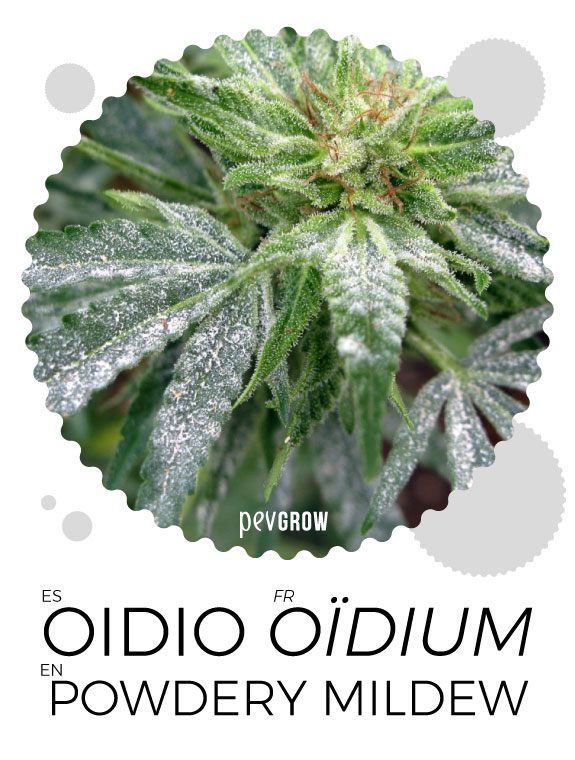
💻 Botrytis, What is it and how do I detect it?
Botrytis is one of the worst fungi that can attack cannabis plants, once we see it has already caused damage. Also called grey mould, it is more common in outdoor crops than indoors, especially when the buds formed are wet.
It is a parasitic fungus, as is powdery mildew, since it needs a host plant that it feeds on. But it also generates toxins that destroy coatings of our plants, leaving them unusable for consumption.
Although Botrytis can appear in any stage of plants (even dead) it is more common to see it in the flowering and ripening phase. The first symptoms that can be seen are leaves with yellow tips or directly dry on the buds, as the first damage occurs inside them. If you look closer you can see a kind of cotton in the flowers, that bud would be to throw away.
How can I fight Botrytis in cannabis crops?
As always, the best thing to do in these cases is to prevent Botrytis from appearing. In indoor growing control humidity and ventilation to ensure that air circulates throughout the growing space. Outdoors try not to get the buds wet since they start to form.
There are also effective natural fungicides that help prevent the appearance of Botrytis, in this case horsetail or propolis. Another important thing is to close wounds on branches and stems with healing products to prevent external agents from entering.
Eliminating Botrytis is a very complicated task, it is best to cut the affected areas carefully so as not to spread the spores. There are products like Botryprot that are formulated for this mission, but it is a difficult problem to eradicate.
Which homemade remedy can I use to end Botrytis?
There are no homemade tricks to completely eliminate botrytis. But there is a home remedy to prevent the attack of this fungus. Mixing skimmed milk, sodium bicarbonate and distilled water with a ratio of 4 parts water to each part milk, and 20 grams of baking soda to each liter of mixture.
For example, if we want to make half a litre of product we have to mix 400 ml. of distilled water with 100 ml. of skimmed milk, stir well and then add 10 grams of bicarbonate. We remove this mixture as much as possible and apply it sprayed on the plants in a preventive way.
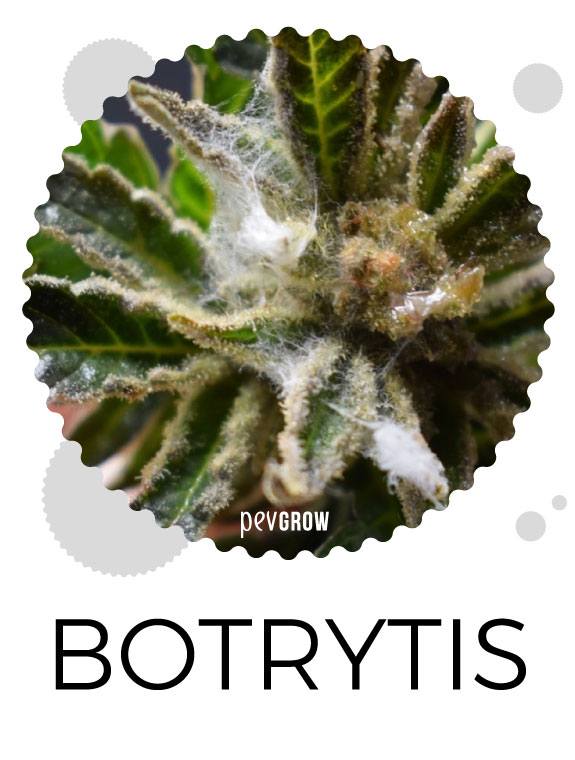
🧐 Mildew, What is it and how can it damage my crop?
Mildew is a fungal species very similar to powdery mildew, at first glance can be confused, as it is like a white powder on the leaves. An easy way to differentiate them is by rubbing the affected areas, if removed it is powdery mildew. This is because mildew penetrates the inside of the leaves, and even if you can remove the top layer you will still see the whitish area.
This fungus usually appears in cannabis crops that are not entirely clean, as it reproduces easily in plant waste. Another factor that accelerates its development is high humidity, especially combined with temperatures between 10 º C. and 25 º C.
What can I do to avoid Mildew?
It is best to keep the crop as clean as possible by removing all the dry leaves we see. Also controlling moisture in indoor crops so that it does not rise too high, and obviously treating plants with preventive fungicides can help a lot too.
Can I eliminate Mildew with a homemade remedy?
Of course you can, chamomile is quite effective in preventing and fighting mildew. To prepare the potion you only have to mix 5 grams of chamomile flowers with 100 ml. of water. Once mixed we add 900 ml. of water to obtain a liter of extract that we spray on the affected plants and also on the healthy ones to prevent this fungal attack.
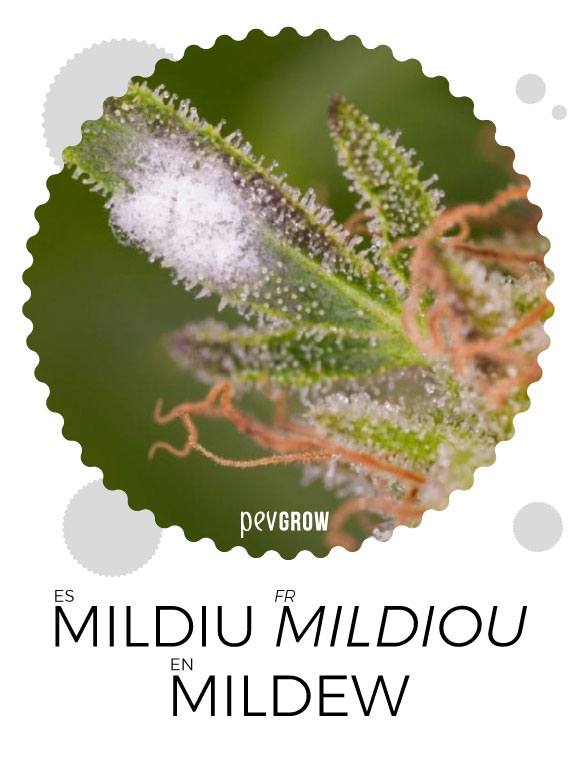
🎬 What kind of fungus is Fusarium?
Fusarium is one of the most feared fungi in cannabis cultivation, as it can kill the plant in a matter of hours. This fungal species attacks the roots and vascular system of plants, preventing the flow of sap.
Because it’s such a destructive fungus when you see the first symptoms, it’s too late. One day you arrive and see your little plant that seems to lack irrigation, with fallen leaves and sad. But when you get close you discover that the substrate is wet, and that’s when you say… It can’t be!
You may also see the problem on a single branch, with all the leaves dropped, and the rest of the plant looking normal. If you look closer, you will see the stem of that branch takes on different tonalities, in that case you have to cut and hope it does not reproduce.
How can I prevent the appearance of Fusarium in Cannabis plants?
This plague has no cure, so there is nothing left but to prevent as much as possible so that it does not arise. Indoors, all tools must be disinfected between crops. We must also try not to bring the spores from outside, most of the time we are the ones who act as transporters on the clothes. Keep the humidity not too high and the same as the temperature, as a mixture of both is the best environment for the development of the Fusarium.
Another thing that helps a lot are the Trichodermas, that is, beneficial fungi that colonize the root system. This micro-life besides helping to prevent against Fusarium and other malignant fungi, helps our plants to eat, so they are highly recommended.
Disinfecting irrigation water is also a good idea, especially in hydroponics, aeroponics or anyone where plants share irrigation water.
Are there effective homemade remedies against Fusarium?
Well, to eliminate it there is no homemade trick, but to try that it does not reach our crops, or that the spores do not develop, we can use propolis, which is a natural fungicide effective as a preventive.
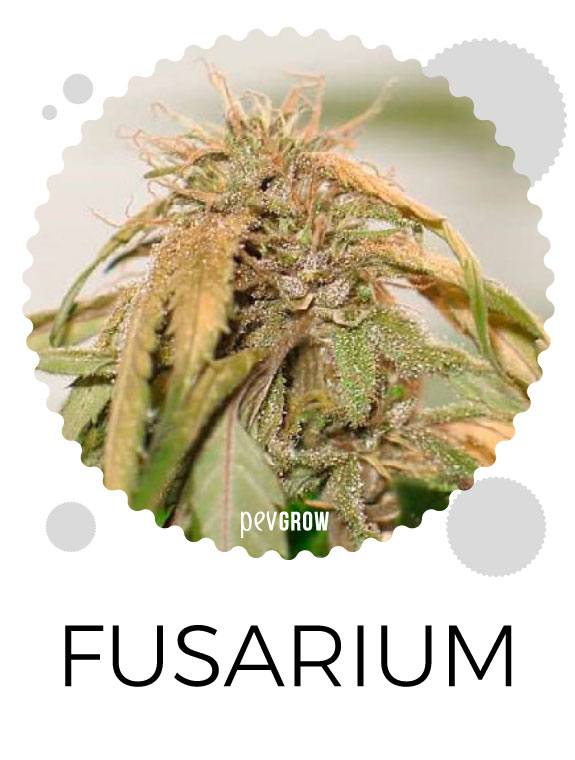
📱 What is Pythium and how do I recognize it?
Pythium can be confused with Fusarium because of its early symptoms. It is also called Root rot, and represents another of the most lethal fungi that can attack Cannabis plants.
It usually infects root systems that are kept moist, such as hydroponic crops. It can also appear in soil or coconut when the pot is not oxygenated or drained well. Pythium fungus changes the color of the roots and they become dark, and although it can be eliminated, the damage it causes and what it costs to get rid of it completely, make it more interesting to eliminate those plants although, as we always say, the best thing is to prevent.
How can I prevent the appearance of Pythium?
One of the safest, most effective and economical ways to prevent this and other root fungi is with the use of beneficial fungi and bacteria. Trichoderma and Mycorrhizae can act together to protect the roots from invasion by dreaded fungi such as Pythium and Fusarium.
The ideal is to add this microlife both in the substrate and in the first irrigations, if it is transplanted we repeat it in the new substrate and the following irrigations. This microlife, in addition to defending the root system, helps get nutrients to the roots of our favorite plants.
It is also important to respect the dry cycle between irrigations, and if we cultivate in hydroponic or aeroponic we have to oxygenate to the maximum the water of the deposit.
In the event of suffering the attack of this malignant fungus, although there are products to eliminate it, we don’t recommend trying to fight it, loss of production and time is not worth it. It is more interesting to start over, but first disinfect the entire growing area as much as possible.
How can I treat Pythium with homemade remedies?
As with Fusarium, a Pythium attack is very difficult to eradicate, and damage will always remain. So we can only prevent and pray that it does not visit us.
Horsetail is effective for prevention against Pythium and other types of fungi that affect cannabis. Mix 100 grams of ponytail per liter of water, heat the mixture and stir well. Then we let it cool down and filter the water with the help of a strainer and we have our own fungicide ready.
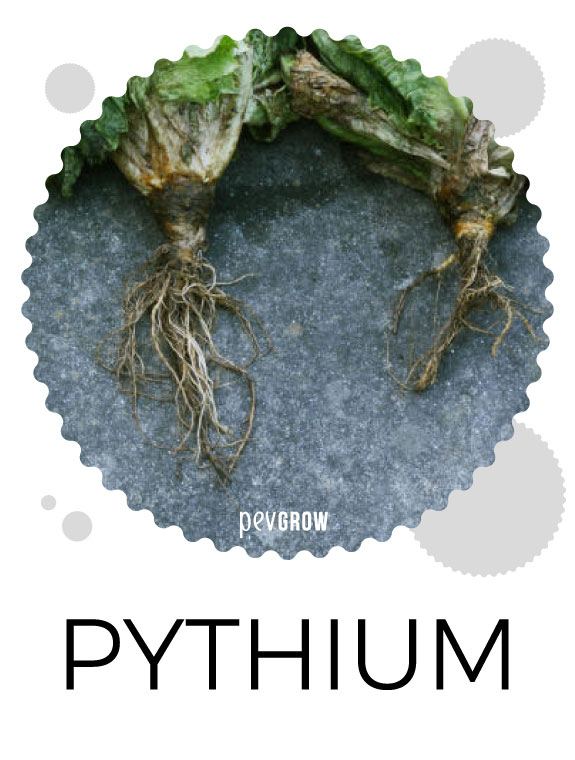
👾 What is the fungus known as Rust?
Rust is a fungus that normally appears in humid environments. Their spores spread through the air, where they can last more than 50 days until they find the perfect medium to grow. When these spores rest on a marijuana leaf, they penetrate the epidermis and begin to develop.
The first symptoms that you perceive of a Rust attack are small spots on the leaves, of different colors, brown, yellow, orange and reddish. The surface of the leaf ceases to be smooth, with small undulations and bulges that can cause necrosis and even dry it out.
An infected plant of Rust is difficult to cure, as is the case with other types of fungi that affect cannabis. But the good news is that with a little prevention and care it’s easy that it never appears, so let’s see how to avoid the appearance of the dreaded Rust.
What’s the best way to prevent Rust attack?
A good ventilation and cleaning of the crop helps a lot both for this one and for other mushrooms. Preventive fungicides such as sulphur or horsetail can come in handy for this purpose, as well as propolis and commercials used against mildew or powdery mildew.
How can I fight Rust with homemade remedies?
Within the different effective homemade remedies against Rust we highlight the garlic extract, as it also has other properties. To produce it we have to mix 3 or 4 cloves of peeled garlic with 1 litre of water, and let it macerate for 24 hours (It is better if the water is warm or a little hot).
Then we dilute 100 ml. of this mixture for each liter of water that we are going to use. For example 3 liters of water with 300 ml. of the prepared mash, and we already have our homemade trick against Rust.
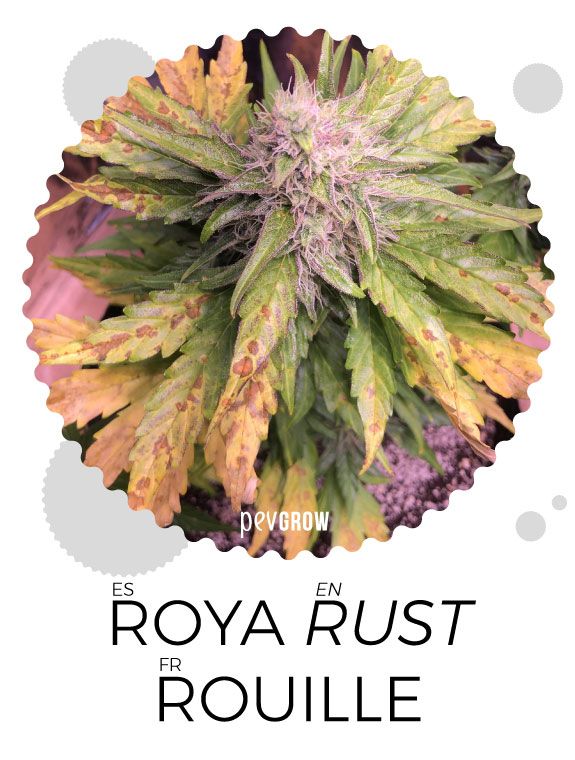
▶ How can I recognize the Bold fungus in a cannabis crop?
Bold is easy to detect because, as its name suggests, they are black spots that appear on the surface of the leaves. This fungus does not appear spontaneously, it always comes out as a consequence of some other previous attack, usually of insects like the whitefly.
Also known as Tizne or Soot, this fungal attack is not one of the most serious, its eradication is not complicated, but it is laborious.
How can I prevent or eliminate Bold from my crops?
In order to completely eliminate this fungus from the crop, it is essential to first eliminate the insects that have caused it. To do so, it is first necessary to detect with a microscope what type of pest it is, and then act.
Once the plague is exterminated, it is necessary to clean the affected leaves of Negrilla with the help of potassium soap and a cloth. We can spray all the leaves, wait a few minutes for the soap to act and then rub the affected leaves with the cloth to remove black stains.
To prevent the appearance of Bold we have to avoid being attacked by insect pests, especially mealybugs, aphids and whitefly. These insects among others, when they suck the sap of the leaves and stems create a sweet molasses that is the one that causes the appearance of this fungus, reason why if we defend the culture of those insects sure that the Bold will not appear.
Effective homemade remedies for treating Bold in marijuana crops
Common soap attached to the pressurized water can be a great ally to eliminate bold in a homemade way. If the water is warm or hot it is more effective, and if after spraying under pressure we rub the affected leaves with a cloth even better.
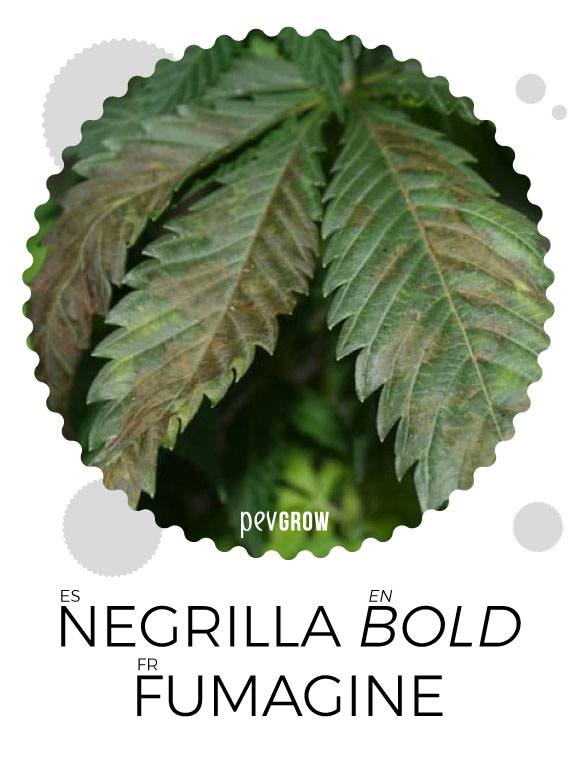
🎯 What is Alternaria and how can I detect it?
Alternaria is one of the most destructive fungi of crops in general. Its spores can expand by any means, both air and water. It proliferates faster in environments with high humidity and temperature, although it can also appear in places with sudden environmental changes.
The first symptoms of Alternaria attack on cannabis crops is on the leaves of plants. Dark brown or grey spots that end up producing necrosis that dries the surface. These spots may be oval or circumferential in shape, and may form concentric circles on both leaves and stems.
It usually appears or reproduces more easily at medium-high temperatures, and also in pots where the substrate remains moist for a long time.
How can I prevent and eliminate Alternaria?
Not over watering and respecting the dry cycle between each watering helps a lot, as well as a proper cleaning of the crop in general. Ventilation is also important, it is necessary to control that humidity bags do not form, especially indoors and in the greenhouse.
Prevention is important as always, especially during spring and autumn, when there are more spores in the air (cause of some allergies).
Using a fungicide such as Propolis regularly during the vegetative growth period will help prevent the appearance of Alternaria.
Can I remove Alternaria with homemade treatments?
You can if you start treating from the very first symptoms. The best is the ponytail, which in addition to fungal properties serves as an insecticide.
To prepare the potion, mix 25 grams of horsetail with one litre of water and stir for about 15 minutes. Then let the mixture macerate for 24 hours, then stir well again and filter it with a sieve.
This mixture must be diluted in water at a proportion of 4 parts of water for each part of the concoction. It can be sprayed from small plants as a preventive once a week. In case of treatment to eliminate, spray well for 3 days in a row and repeat after one week.
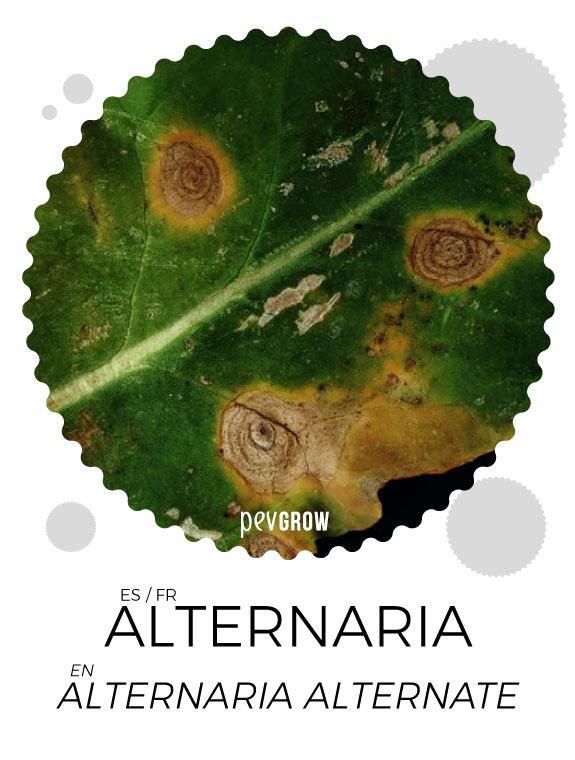
🔥 What is nursery disease or Damping-off in cannabis crops?
Nursery disease rather than a fungus itself is a situation caused by one or more fungal attacks. It attacks seedlings or cuttings during the rooting phase, when the plants are most vulnerable, so it can be highly destructive.
We say it can be a combination of different fungi because it can be Fusarium, Pythium or Botrytis. You can see how the stem weakens, bending the plant to death, and once attacked, that plant can not be recovered.
You can usually see a kind of white ring at the base of the stem, at substrate level. When you see it is late, that specimen will be lost, but it is time to act to try to save the plants nearby, as nursery disease spreads quickly throughout the crop.
How to prevent the appearance of nursery disease?
This pest does not happen by chance, it occurs in media with excessive humidity or heat, or both. It may also be that the fungus was already present in the soil or some tool used for cultivation. It can often be seen in hot places when they germinate late, or in late spring or summer, when the substrate is overheated coinciding with rooting.
In order to avoid its appearance try to ventilate the cultivation space correctly, keep everything as clean as possible, and air the greenhouse from time to time if you are rooting cuttings.
Can nursery disease be prevented with homemade remedies?
You can and in fact the best way to prevent Damping-off or nursery disease is with a homemade trick. Because, what’s more homemade than germinating inside the house?. That simple step will go a long way to avoiding this destructive fungus.
If we germinate and give a little growth indoors, and we already take them out and transplant them with several pairs of leaves the probability of receiving this fungal attack is greatly reduced.
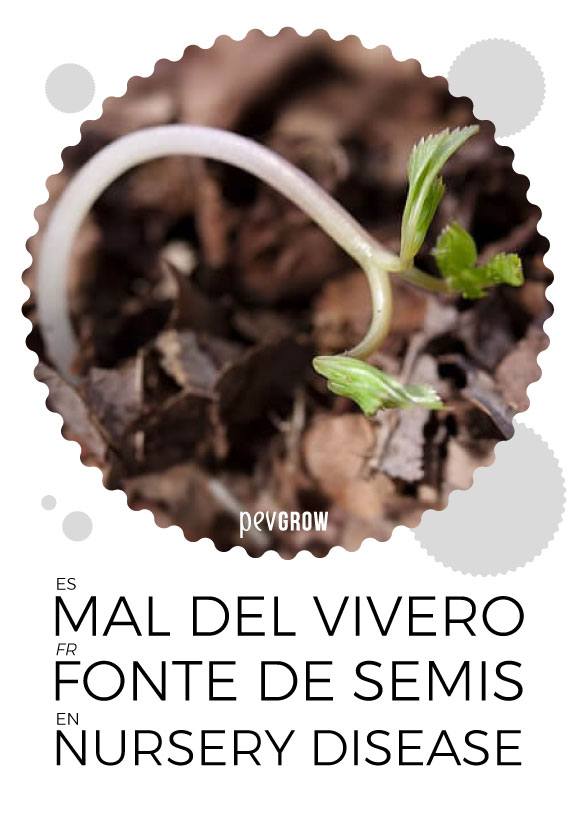
– Diagnosing diseases in cannabis plants
– Lack or excess calcium in the marijuana plant
– How to make a washing roots and start over
✍ Conclusions
Cannabis fungi appear more in cultivation areas with poor ventilation, high humidity, temperature or both, and especially in areas with poor cleaning.
It is always interesting to treat the plants from small with preventive fungicides, as well as to have a good hygiene in the culture in general.
There are other problems associated with diseases of cannabis plants such as viruses or bacteria, also other less common pests of fungi, but in this post we’ve gone over the ones that normally attack our beloved plants the most. And you? Do you know other fungi that affect Cannabis? If so, please tell us more, and if you find this article interesting share it so that others may benefit as well.😜



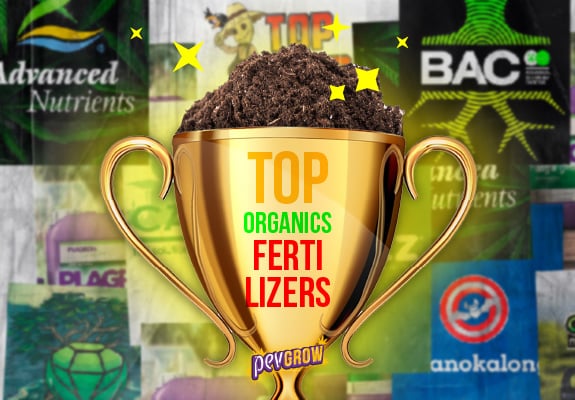


Thanks very very much
Love everything you do
James Roberts